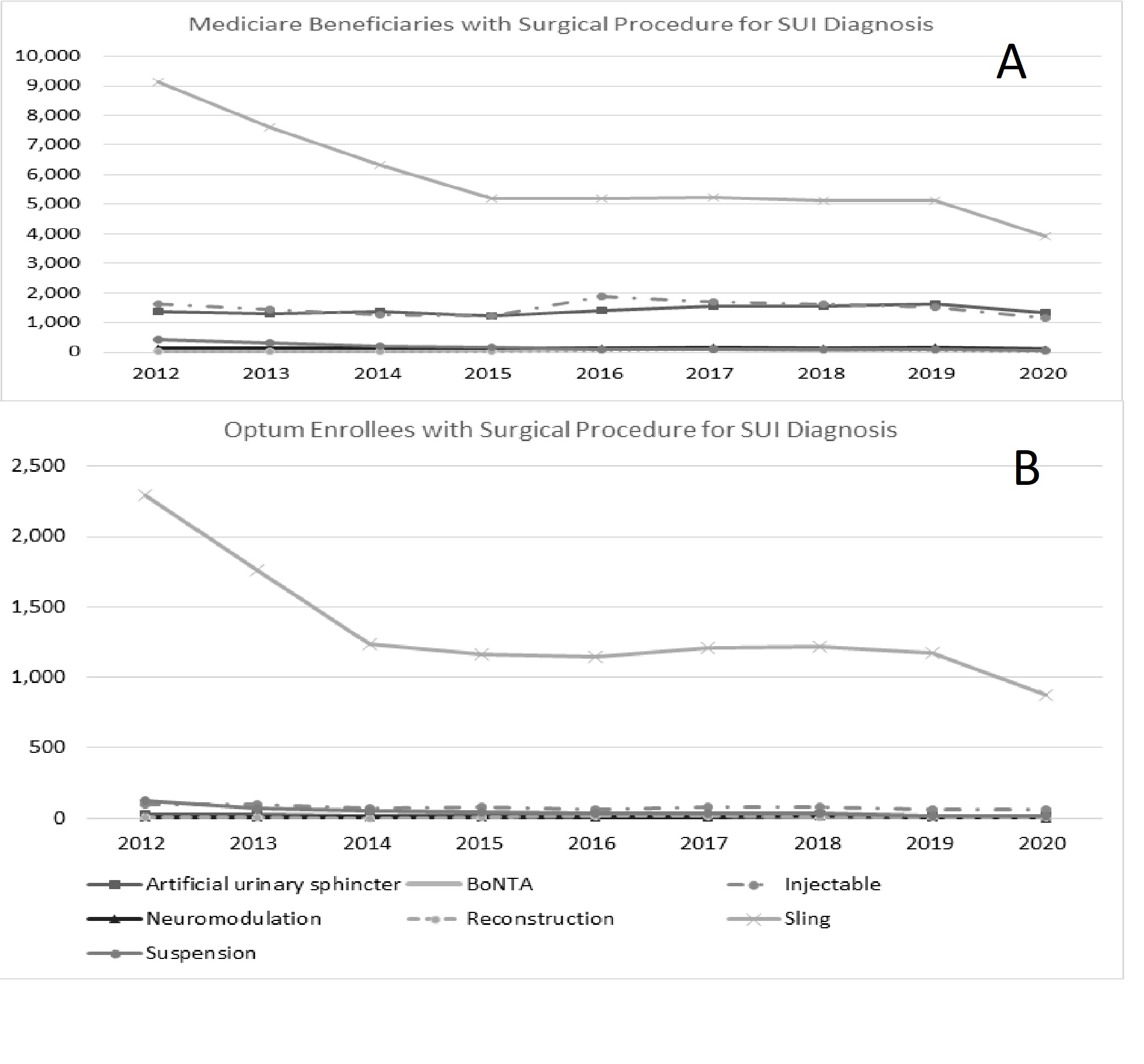Back
Introduction: Stress urinary incontinence (SUI) is a major quality of life problem for many people. In women, SUI is associated with pelvic organ prolapse (POP) and in men after a radical prostatectomy. A safety review started in 2011 by the FDA of POP mesh resulted in the 2019 recall. This study reviews the prevalance and procedure trends for SUI between 2012 to 2020.
Methods: Using the 100% Optum® Clinformatics® Data Mart data and 100% national Medicare Fee-for-Service data, we identified subjects claims for urinary incontinence (UI) and any procedures performed for UI. Results reported as mean ± standard deviation.
Results: From 2012 - 2020, the mean prevalence of any UI in the 18-64 age group was 37,529 ± 3292 or 0.62% of the population. In the Medicare population (aged 65+), it was 1,439,221 ± 90507, or 5.7% of the group. The Female to Male ratio in the <65 yr group was 2.52:1 and in the 65+ was 5.31:1. The Medicare mean SUI prevalence was 212223 ± 14292 (0.84% population), and the Optum group was 13,179 ± 1,535 (0.22%). 38,677 Medicare patients received procedures for UI in 2012. This increased to 54,122 by 2019, falling to 45,667 during COVID. In 2012, 12,286 patients received SUI procedures, which plateaued at 8,670/yr for 2015 to 2019. In 2020, 6508 patients had a SUI procedure. (Breakdown in Fig 1A). 4020 patients with UI aged 18-64 got a procedure in 2012, which decreased by 45% to 2635 in 2019 with a dip for COVID to 2020. The numbers plateaued from 2014 to 2019 at 2500 patients/yr approximately. The SUI patient numbers for this group decreased from 2501 in 2012 to 967 in 2020, plateaued between 2014 and 2019 at 1250 patients/yr approximately. (Breakdown in Fig 1B) There was a 50% decrease in patients getting sling procedures. Patients obtaining artificial urinary sphincter, and injectables remained constant. Men receiving artificial urinary sphincter, slings, and injectables has remained even in the 65+ age group. However, in the 18-64 age group, men obtaining slings decreased.
Conclusions: The claims prevalence for UI has increased in older age and decreased in younger patients. Sling use has decreased in all female patients and younger men. The overall decrease in procedures for SUI, appears partly due to decreased reporting of incontinence claims in the younger population, together decreased Sling procedures in female patients. SOURCE OF
Funding: NIDDK Contract Number GS-10F-0133S

Moderated Poster Session
Session: MP48: Health Services Research: Practice Patterns, Quality of Life and Shared Decision Making II
MP48-16: Trends in Stress Urinary Incontinence Procedures from 2012 to 2020 From the UDA Project
Saturday, April 29, 2023
3:30 PM – 5:30 PM CST
Location: S505

John Paul Lavelle, MD (he/him/his)
Director Neurourology, Urodynamics and Voiding Dysfunction, VA Palo Alto HCS
Stanford University
Poster Presenter(s)
Introduction: Stress urinary incontinence (SUI) is a major quality of life problem for many people. In women, SUI is associated with pelvic organ prolapse (POP) and in men after a radical prostatectomy. A safety review started in 2011 by the FDA of POP mesh resulted in the 2019 recall. This study reviews the prevalance and procedure trends for SUI between 2012 to 2020.
Methods: Using the 100% Optum® Clinformatics® Data Mart data and 100% national Medicare Fee-for-Service data, we identified subjects claims for urinary incontinence (UI) and any procedures performed for UI. Results reported as mean ± standard deviation.
Results: From 2012 - 2020, the mean prevalence of any UI in the 18-64 age group was 37,529 ± 3292 or 0.62% of the population. In the Medicare population (aged 65+), it was 1,439,221 ± 90507, or 5.7% of the group. The Female to Male ratio in the <65 yr group was 2.52:1 and in the 65+ was 5.31:1. The Medicare mean SUI prevalence was 212223 ± 14292 (0.84% population), and the Optum group was 13,179 ± 1,535 (0.22%). 38,677 Medicare patients received procedures for UI in 2012. This increased to 54,122 by 2019, falling to 45,667 during COVID. In 2012, 12,286 patients received SUI procedures, which plateaued at 8,670/yr for 2015 to 2019. In 2020, 6508 patients had a SUI procedure. (Breakdown in Fig 1A). 4020 patients with UI aged 18-64 got a procedure in 2012, which decreased by 45% to 2635 in 2019 with a dip for COVID to 2020. The numbers plateaued from 2014 to 2019 at 2500 patients/yr approximately. The SUI patient numbers for this group decreased from 2501 in 2012 to 967 in 2020, plateaued between 2014 and 2019 at 1250 patients/yr approximately. (Breakdown in Fig 1B) There was a 50% decrease in patients getting sling procedures. Patients obtaining artificial urinary sphincter, and injectables remained constant. Men receiving artificial urinary sphincter, slings, and injectables has remained even in the 65+ age group. However, in the 18-64 age group, men obtaining slings decreased.
Conclusions: The claims prevalence for UI has increased in older age and decreased in younger patients. Sling use has decreased in all female patients and younger men. The overall decrease in procedures for SUI, appears partly due to decreased reporting of incontinence claims in the younger population, together decreased Sling procedures in female patients. SOURCE OF
Funding: NIDDK Contract Number GS-10F-0133S

